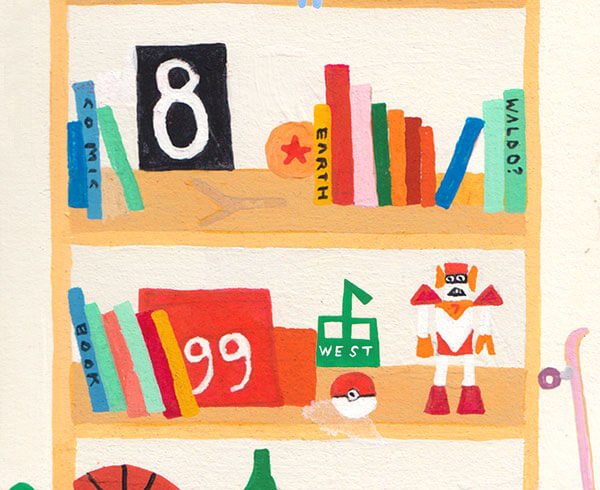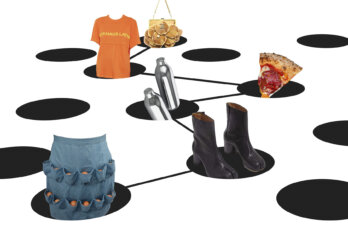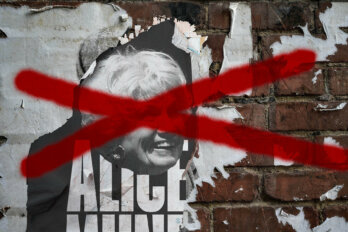If viewed as the overlap between two individual areas of experience, common ground can be seen as the darkened area of the Venn diagram in which all similarities are included and all differences are excluded. A couple first meets. Born within six months of one another, within the same medium-sized city, and of comparable socio-economic class, they automatically overlap somewhere between 33 to 35 percent. Make the city Calgary and make them both only children who—as a consequence of their solitudes—have both grown up somewhat unsociable and somewhat bookish. If both dutifully attended music lessons in guitar and piano to complement their school work, their common ground might go as high as 40 to 55 percent.
The 60 to 45 points of difference in their nature or nurture might place them in separate post-secondary programs—her excess empathy and caring predisposing her to the liberal arts and a career in education and his pedantic obsessive nature predisposing him to the physical sciences and a career in mechanical engineering—but their extracurricular interest in music persists. He forms a band with some other overachieving schoolmates, and she shows up at one of their underattended shows. With such common ground, the two have a fair chance of falling into conversation at the mostly empty tavern performance space after the show. She nurses her one-beer-limit beer, and he orders his alcohol-is-a-slippery-slope coffee, and later, when they fall together and become a couple, they will likely use the money they save with a city-hall wedding for a detached home within walking distance of a school and with three bedrooms: one bedroom for them, one for a child, and one for a home office. Later still, when that one child is born as tangible, living proof of their common ground and is named Benjamin, the parents will, for a short while, overlap more than they ever have or ever will again.
For group dynamics, a diagram that is composed of a couple of paired circles insufficiently conveys the common ground shared by each separate individual, and for complicated configurations, such as three, four, or five members, the trippy twisted geometry of a whirling and twirling Spirograph doodle might better illustrate pockets of similarities and differences. A boy seeks out new friends. Make the boy Benjamin. Make Benjamin the new kid in school because his family has moved recently, and in his new class, he stumbles into a preexisting group of three mathletes with whom he shares little common ground. Relocated from the medium-sized city of Calgary to the medium-sized city of Ottawa and enrolled a full month late in the fall term, Benjamin shares only slivers and thin crescents of common ground with any one of new friends Eli, Sal, and Alexander.
In Sal, the stubby follower sheep of a friend, whose swears are often illogical, Benjamin recognizes a fawning need to be liked. In Eli, the mean-streaked piece of work whose violence is barely contained, Benjamin sees an unpredictable danger but also recognizes his own feelings of helpless rage. In Alexander, the tired philosopher king whose bemused laughs are worth working for, Benjamin sees a careless cynicism but also recognizes his own sense of defeat. Counted separately, perhaps the common ground he shares with any one of his new friends accounts for no more than 15 to 20 percent, but representing a full sum total of several times that, he is welcomed into their darkened overlapping areas.
As a late addition to the group, Benjamin does not share the rich history his new friends have—a past of misadventures and triumphs stretching from junior kindergarten to grade six—and, in addition, he does not share their gifts for arithmetic. Numerically gifted beyond their years, all three of Benjamin’s new friends play for the math team, and Benjamin is, at best, adept. Studious by nature and by nurture, Benjamin has almost just about gotten the hang of cross multiplication as long as it isn’t sprung on him entirely in an ungenerous pop quiz, but he cannot at all keep up when the three friends try to trip one another up with Cartesian practice-test questions at recess, shove properties of integers at one another in the playing field during daily physical activity, or mock one another’s lack of precision with a protractor and compass in the gymnasium-auditorium at lunch hour.
This fundamental difference might not be the stumbling block it first seems, though, for common ground is not static. It inevitably expands its borders over time through shared experience, and 45 to 60 percent may well beget 48 to 63 in a matter of school weeks. Benjamin spends lunch hours with Sal and Eli and Alexander. Make their activity an illicit activity as he is welcomed into the fold, with lunch hours passed blocks and blocks off school property, behind the Good and Quick Gas and Sip, and the percentage of common ground can balloon with each of their shared trespasses. Welcomed along to their retreat behind the convenience-store–snack-bar gas station for grumble-and-grouse-and-shoot-the-shit sessions far from the workaday world, Benjamin shares in the respite of salted language and tobacco cigarettes, the secret of their prohibited endeavours drawing them closer together, and while he cannot calculate calculus and may never become secretary treasurer of the coding club, Benjamin learns he has other skills. He learns that his attention and memory have served him well.
He shares an anecdote about his father’s university band, Sea Monkey See, Sea Monkey Do, the box of unsold EP CDs that now inhabits a closet, and the jewel case’s hand-drawn cover art depicting an ape playing with its own feces. He shares an anecdote about Parc Safari, the waterpark–community-zoo–drive-through safari in Quebec that his father took him to back in October when they first moved to Ottawa and the deer enclosure they walked through called le sentier des cerfs where they saw an unwise squirrel hunting and gathering deer droppings for the coming winter. He shares a story about the Environment Canada glass-case exhibit he examined at the Calgary airport on his way to Ottawa and the displayed collection of illegal animal by-products forbidden for import and export, including cosmetic compacts made from the front paws of tigers, key chains of infant elephants carved from the ivory of adult elephants, and packets of finely ground powder made from rhinoceros tusk to be sold “for love or medicine.” Sal and Eli and Alexander laugh at the anecdotes, and integrating through ingratiating, Benjamin becomes less and less an interloper and pushes himself past the halfway mark into a 51 to 54 percent range.
Not all common ground can be divided equally, however. While a group of four friends might represent six separate paired relationships—Sal/Eli, Sal/Alexander, Sal/Benjamin, Eli/Alexander, Eli/Benjamin, and Alexander/Benjamin—the total will not be broken down to six identical divisions. Over time, as the fall term progresses into first snow, after many excursions to the Good and Quick Gas and Sip have passed, hidden parallels and connections between pairings will emerge. For example, Benjamin learns that, though outwardly unalike, stubby follower Sal and nasty-piece Eli have both internalized and inherited their parents’ socially and politically conservative world views. As well, both collect and trade the Scandinavian-fantasy-themed collectible trading-card series the Broadswords of Gungnir with a passion that borders on mania, and on weekends, the two visit each other’s homes to debate the comparative strength of vile lindworms and honourable boatmen. Similarly, similarities heretofore unseen between Benjamin and Alexander emerge. The biggest is the broken homes in which they live.
Shortly after moving to Ottawa, Benjamin’s mother and father decided to try out a trial separation, dividing up their common ground, and such matters are not easily discussed with a new friend. Benjamin cannot say his father’s forgotten box of unsold EP CDs has moved from the executive townhome closet to a closet in a low-rise apartment complex, cannot say his father took him to Parc Safari as a prelude to the announcement of the break in their home, cannot say that, before the other two events even occurred, his father laugh-sneered and nodded at the ground-down rhinoceros tusk in the Calgary airport. Benjamin has said none of this, and yet he suspects that Alexander understands more than he lets on.
One Thursday in December, before the upcoming school break, after the second lunch bell rings and the group of four friends is scurrying back to school property, exchanging peppermint chewing gum to hide the tobacco on their breath, Benjamin receives an out-of-the-blue invitation. Alexander asks him if he wants to come over during the holiday break. With a nod to downplay the invitation’s import, Benjamin mutters, “Yeah,” not at all revealing that the moment is a moment of mutual recognition and certainly not admitting that his thoughts have turned to his mother. He thinks of his mother and how glad she will be to learn he has made such a close friend, how glad she will be to hear of the invitation, how glad she will be to drive him over to the home of a new friend. His mother will be reassured that Benjamin is settling in all right in his new class in the new school in the new city and that all will grow better given time. Time—with its restorative nature and curative properties—will heal the wounds inflicted by family.
There is a snag, though, because in a city of under a million people such as Ottawa, small coincidences and small connections hide around every corner, and as it turns out, Alexander the philosopher king resides in the same low-rise apartment complex of mustard-yellow brick buildings as Benjamin’s father—two mustard-yellow buildings down and on the other side of the emptied-out outdoor pool that seems to have sat for some years emptied and in disuse. An unhappy happenstance. Though his parents once shared much between them, time and circumstance have undone many of their connections, and Benjamin reflects that his parents’ temporary separation will likely be not at all temporary.
He worries that the low-rise does not bode well for the visit, and he is right to be concerned. In the car outside the low-rise apartment, as his mother waves him off from the front seat and tells him to have a good time, she smiles to betray neither worry nor dismay, but Benjamin has learned to calculate losses well. He can subtract all that has been taken from both of them within a few short months—city, home, friends, acquaintances, and all and sundry. He estimates their shared losses at 60 to 75 percent or perhaps as high as 70 to 85 percent.
Peering into the dimly lit foyer hall of the shabby low-rise, where a stack of PennySaver flyers and an orphaned tennis shoe lie on the scuffed tile floor, Benjamin is not at all sure that this is common ground he wants, but he struggles against his uncertainty, and he walks in and up the littered stairwell to the third-floor apartment where Alexander waits to open the door in greeting. In the hallway outside the threshold, Benjamin looks in over his friend’s shoulder and spots a makeshift room in the living-room–dining-room alcove with a pastel-blue bedsheet strung from one wall to another wall, and through a gap in the imperfect partition, he sees an unmade bed tangled with thrown-off clothing, and his uncertainty grows greater to outright reluctance. Walking down the low-ceilinged hall to his friend’s bedroom, Benjamin realizes that, though he and Alexander are of the same age and they live in the same city, they may not be of comparable socio-economic backgrounds, which he knows should not make him feel awkward, because all people are equal in rights and dignity, but which makes him feel a little awkward anyway. For a snack, they open a box of Ritz and two pops, and as they sit on a throw rug of questionable cleanliness on the floor of the crowded and cluttered bedroom, Alexander the king explains that the empty top bunk of his bunkbed was once his older sister’s, but now his mother said they were getting too old to share, so his sister took the second bedroom and his mother set up her belongings in the apartment’s living-room–dining-room area. His mother is out today because she’s a social-services worker who sometimes has to do weekend outreach, so the sister is supposed to be the sitter, but since she works weekends at the Monsieur Pet at the mall, she is out as well.

Nodding, Benjamin feels his sense of order offended by the disorder around him, but he suppresses his reluctance and his urge to leave. He nods more. There’s something Benjamin should see, Alexander says. It’s something Benjamin will maybe appreciate, he says, and he drags a low square box out from underneath the bottom bunk of the bunkbeds. It’s a box left forgotten by his father, Alexander says, and in the ensuing pause, Benjamin realizes they are speaking of things they haven’t spoken of before. Their darkest of common grounds. He right away thinks the box must contain his friend’s father’s collection of pornography. Confusing pictorial essays with progressive images that illustrate ladies in increasing states of undress. Confusing double-page spreads of soft-focus photography in fancy and also schmanzy bedroom and hotel-room locales. Confusing cartoons punning on private parts.
This box is not a box of such confusion, though. It’s a box of dead-animal limbs. Well, not really dead-animal limbs—but a collection of lucky rabbit feet—so, yeah, a box of dead-animal limbs. Again, Benjamin suppresses the urge to flee, and instead, he leans forward to look inside, where there’s mostly key chains of rabbit feet but also pendants with rabbit feet. Most of the pendants are attached to what look like necklace chains, but one foot has been grafted to a novelty pocket flashlight that doesn’t light up anymore. Many of the feet are dyed unnatural colours not found in rabbits and hares in nature—greens and blues and one magenta—and the dark dyes not only cover the fur but also have worked their way down into the flesh of the pads under the animal paws and into the cracked grain of the nail fragments peeking out from the furred finger digits. The part of Benjamin that wants to run also wants to scream that the box is a nightmare box. A box of nightmare horror experiments—except for the flashlight, which is maybe more like a science-fiction experiment—but another part of Benjamin understands something deeper. In opening the box, Alexander is opening up to him, and with a nod to downplay the moment’s import, Benjamin mutters, “Yeah.” He accepts what his friend wants to give him.
With nothing much to say, they close the box and return it to its safe place under the bottom bunk, from where Alexander retrieves a tangle of cords and game controllers and Killcraft WarMachine IV. Although electronic and video games are not pastimes Benjamin has encountered, he reasons that after travelling all the way from Calgary to Ottawa, after entering the mustard-coloured low-rise, and after passing down the long dark hall into this crowded and cluttered bedroom, an alternative postapocalyptic world of undead hordes and insectoid armies should be within his reach. Settling into the first-person shooter game, Benjamin lies on his stomach next to his new friend and decides not to think about the floor, and an hour later, when their backs are cramped and they bring down pillows from the bunkbeds to the floor, he props the cushion up under himself and decides not to notice the tomato-sauce sweat smell coming from the pillow case. Another hour later still, he is entirely absorbed.
Benjamin lets himself be drawn in as he and Alexander tear ass together through the video game’s fetid trenches, past fallen comrades crying out in terror. Lost limbs pile up all around him, but he runs forward unfazed—unfazed, that is, until his hand slips on the game controller and his first-person soldier slips on the mud below. On screen, a mammalian mutant mass closes in above, everywhere, and all around. Offscreen and beside him, Alexander yells, “Ohnonono” with a laugh. Benjamin’s first-person cannot rise up from the mud, and the creatures all over him grow all-consuming, but he can see up ahead where Alexander’s first-person comes to a halt and glances back. Panting with the overacted exhaustion of an animated character, he turns to lumber back and reach out a gloved hand. This sacrifice lasts for no more than a moment, and as the split screen fills with a mirrored image of attacking mongrel ferrets, weasels, and martens, and as their first-persons both suffer painful deaths, the boys jolt back, laughing and letting loose a string of unseemly and appropriate swears. A hoot and a half, another 5 to 10 percent is gained.




